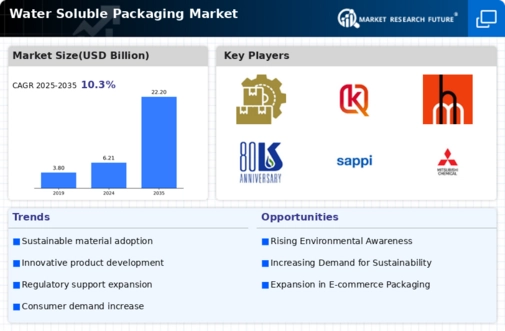Rising Environmental Concerns
The increasing awareness regarding environmental issues is a primary driver for the Water Soluble Packaging Market. Consumers and businesses alike are becoming more conscious of their ecological footprint, leading to a shift towards sustainable packaging solutions. Water soluble packaging, which reduces plastic waste and promotes biodegradability, aligns with these environmental goals. According to recent data, the demand for eco-friendly packaging solutions has surged, with a notable increase in market share for water soluble options. This trend is likely to continue as more companies adopt sustainable practices, thereby enhancing their brand image and meeting consumer expectations. As a result, the Water Soluble Packaging Market is poised for growth, driven by the collective push for environmentally responsible alternatives.
Innovative Product Development
Innovation plays a crucial role in the expansion of the Water Soluble Packaging Market. Companies are investing in research and development to create new formulations and applications for water soluble materials. This includes advancements in the production of films and coatings that are not only effective but also cost-efficient. The introduction of novel products, such as water soluble pouches for single-use items, has captured consumer interest and opened new market segments. Market data indicates that the innovation-driven segment of the industry is experiencing rapid growth, with projections suggesting a compound annual growth rate that outpaces traditional packaging solutions. This focus on innovation is likely to attract investment and foster competition within the Water Soluble Packaging Market.
Consumer Demand for Convenience
The modern consumer's preference for convenience is a significant driver of the Water Soluble Packaging Market. As lifestyles become increasingly fast-paced, there is a growing demand for packaging that simplifies the use of products. Water soluble packaging offers a unique solution by providing easy-to-use, single-dose formats that eliminate the need for additional measuring or handling. This convenience factor appeals to a wide range of consumers, from households to businesses. Market analysis shows that products packaged in water soluble materials are gaining traction, particularly in sectors such as food and personal care. The trend towards convenience is expected to continue influencing purchasing decisions, thereby propelling the growth of the Water Soluble Packaging Market.
Regulatory Support for Sustainable Practices
Regulatory frameworks are increasingly favoring sustainable packaging solutions, which significantly impacts the Water Soluble Packaging Market. Governments are implementing stricter regulations on plastic usage and promoting biodegradable alternatives. This regulatory support not only encourages companies to adopt water soluble packaging but also provides incentives for innovation in this sector. Recent legislative measures have been introduced that mandate the reduction of plastic waste, thereby creating a favorable environment for the growth of water soluble packaging solutions. As businesses strive to comply with these regulations, the Water Soluble Packaging Market is likely to see an uptick in demand, as companies seek to align their practices with governmental expectations.
Increased Investment in Sustainable Technologies
Investment in sustainable technologies is a driving force behind the Water Soluble Packaging Market. As companies recognize the long-term benefits of adopting eco-friendly practices, there is a notable increase in funding directed towards the development of water soluble materials. This investment not only supports the creation of innovative products but also enhances production efficiency and reduces costs. Market data suggests that sectors focused on sustainability are attracting significant capital, with projections indicating a robust growth trajectory for water soluble packaging solutions. As more businesses commit to sustainability, the Water Soluble Packaging Market is likely to experience accelerated growth, driven by the influx of investment in sustainable technologies.


















Leave a Comment